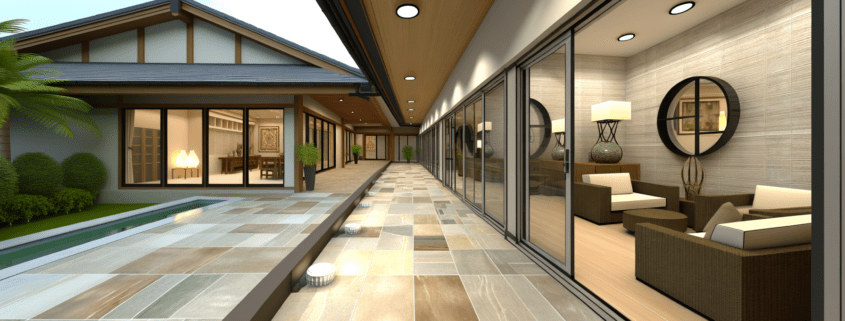Seamless Transitions: Blending Indoor Luxury with Outdoor Living
In today’s architectural landscape, the line between indoor comfort and outdoor serenity is artfully blurred, presenting a harmonious blend of luxury and nature. This design philosophy not only expands living spaces but also infuses daily life with the tranquility of the outdoors. Whether it is through expansive glass doors that open to lush gardens or cozy patios that serve as an extension of the living room, seamless transitions are redefining the essence of sophisticated living.
The Concept of Indoor-Outdoor Continuity
As the boundaries between indoor comfort and outdoor freshness continue to blur, modern homeowners are avidly seeking ways to meld these two realms into a singular harmonious living space. The essence of indoor-outdoor continuity lies not just in the physical blending of spaces but also in fostering a lifestyle that maximizes both the coziness of the indoors and the freedom of the outdoors. For residents of Sonoma County, with its mild climate and picturesque landscapes, such harmony is not only aspirational but attainable.
This unity becomes especially relevant today, as the lines between home relaxation, work, and socializing shift. Bringing the outdoors in, or vice versa, does more than enhance the area’s functionality; it impacts relaxation and well-being. The gentle transition between spaces can alleviate stress, encourage positive social interactions, and create a sanctuary that complements the diverse lifestyle preferred by the inhabitants of regions like Cotati, CA.
Design Strategies for Seamless Transitions
Beyond the structural design, color plays a pivotal role in uniting indoor and outdoor spaces. A thoughtful approach involves carrying a similar color palette from inside the home to the outside, creating a visual connection that seamlessly blends the two areas. The continuity of color scheme can be as simple as matching wall hues with outdoor textiles or as intricate as echoing the interiors with similar shades in landscaping.
Extending Flooring Materials
Flooring is a critical element that can either distinguish or unify spaces. Utilizing the same, or similar, flooring materials for both indoor and outdoor areas lays the groundwork for a smooth transition. Materials like porcelain tiles that mimic natural stone or wood can be carried from indoor spaces to outdoor patios and decks, offering not only an aesthetic alliance but also functional benefits such as durability and ease of maintenance. More information on the advantages of specific flooring materials can be found at This Old House.
Incorporating Consistent Architectural Elements
To further the visual flow, aligning architectural details in both spaces can merge them in the viewer’s perception. This could mean extending rooflines, using similar window styles, or carrying through wood beam designs from inside to outside. The consistency in architecture not only accentuates the design but also conveys an expansive, coherent feel, proposing the idea that the outdoor space is a natural extension of the home.
Blurring the Boundaries with Doors and Furniture
In creating a fluid transition between indoor and outdoor spaces, the choice of patio doors is crucial. Sliding glass doors, French doors, and bi-fold doors each offer a distinct aesthetic and functional impact. They not only allow natural light to infiltrate the living area but also act as a visual link to the outside world. When selecting a patio door, homeowners should consider factors such as the ease of access, the view they wish to frame, and the door’s alignment with the home’s existing design.
Transitional Pieces of Furniture
Furniture that is versatile enough to be used both inside and outside is an essential component in creating a seamless transition. Outdoor sofas with weather-resistant fabrics and finishes can be used in a covered patio space that feels like an extension of the living room. The key is to select furniture that resonates with the indoor design while being robust enough to withstand the elements. This encourages an environment where the transition between the comfort of the indoors and the allure of the outdoors feels instinctive and effortless.
Outdoor Lighting for an Inviting Transition
As the sun sets, the role of lighting becomes pivotal in maintaining the connection between indoor and outdoor spaces. Strategic lighting can enhance the ambiance of an outdoor living area, making it as inviting at night as it is during the day. The use of LED lights, lanterns, or even integrated lighting systems can provide a warm glow that mimics the interior lighting, further blurring the line between inside and outside. It’s crucial to opt for lighting fixtures that are coherent with the overall design theme and the specific requirements of outdoor usage, including durability and safety.
Achieving Openness and Expansiveness
Open concept designs, where walls and barriers are minimized, contribute enormously to the sense of continuity between interiors and exteriors. The strategic use of such layouts can create an expansive feel, as areas for dining, relaxation, and entertainment flow into each other seamlessly. Considerations must be made to maintain privacy and shelter from the elements. Solutions such as strategic plantings, partial walls, and retractable screens can fulfill these needs while keeping the open feel intact, particularly in variable climates like those found in Northern California.
Landscaping to Enhance the Indoor-Outdoor Connection
The landscape is more than just a backdrop; it’s an active player in unifying indoor and outdoor spaces. The careful selection and placement of plants, trees, and hardscaping can extend the visual continuity from the inside out. Using species that complement indoor plants or mirror the home’s color scheme can subtly reinforce the link. Incorporating elements such as water features or garden paths that draw the eye outward encourages exploration and interaction with the outdoor space, enriching the living experience.
Weatherproofing and Maintenance
When designing spaces that bridge the indoors with the outdoors, it’s imperative to consider the impact of weather and the upkeep required to maintain these areas. Materials selected for outdoor use should not only complement the design but also stand up to the elements. Weatherproof finishes, rust-resistant hardware, and easy-to-clean surfaces can ensure longevity and continued luxury appearance. Maintenance routines for outdoor components often demand more frequency and care than indoor ones, specifically in regions like Sonoma County where variable weather can put a strain on outdoor furnishings and structures.
Zoning and Permits
Any significant changes to property structures typically require an understanding of local regulations and, in some instances, permits. Navigating the legalities can be daunting, but it’s essential for a smooth transition from design to reality. Homeowners in Cotati, CA, for example, must adhere to specific codes that govern outdoor construction. Up-to-date information can usually be secured from local government websites, such as Cotati City’s Permit Center, to ensure that any modifications meet the necessary legal criteria.
Seamlessly blending indoor luxury with outdoor living is more than a trend—it’s a lifestyle choice that pays homage to comfort, aesthetics, and a connection with nature. Crafted color schemes, consistent flooring materials, and a thoughtful selection of patio doors and furniture can significantly impact how we perceive and enjoy our living spaces. Including appropriate lighting and landscape designs further enriches the experience, making transitions between interior and exterior not just possible, but also inviting.
While change can be challenging, it is crucial to consider practical aspects like weatherproofing, maintenance, and adherence to zoning laws for a successful and lasting design. Homeowners should not shy away from seeking professional guidance to navigate these more complex aspects of design; after all, the aim is to enhance the quality of life at home for years to come. With thoughtful planning and execution, indoor and outdoor spaces can coexist as a single, harmonious sanctuary that reflects the values and interests of those who reside within.
A seamless transition between indoor and outdoor living amplifies the enjoyment and functionality of a home. It’s a thoughtful process that when done correctly, can extend the comfort of the indoors to the natural beauty of the outdoors, creating a fluid, cohesive environment tailored for relaxation and entertainment alike. So, as we embrace the merging of these two worlds, let’s keep in mind the importance of design, functionality, and the timelessness of enjoying the best of both worlds right at our thresholds.
Discover the art of blending serene indoor comfort with the invigorating allure of outdoor living. Contact us today to begin your journey towards sophisticated, integrated living.



